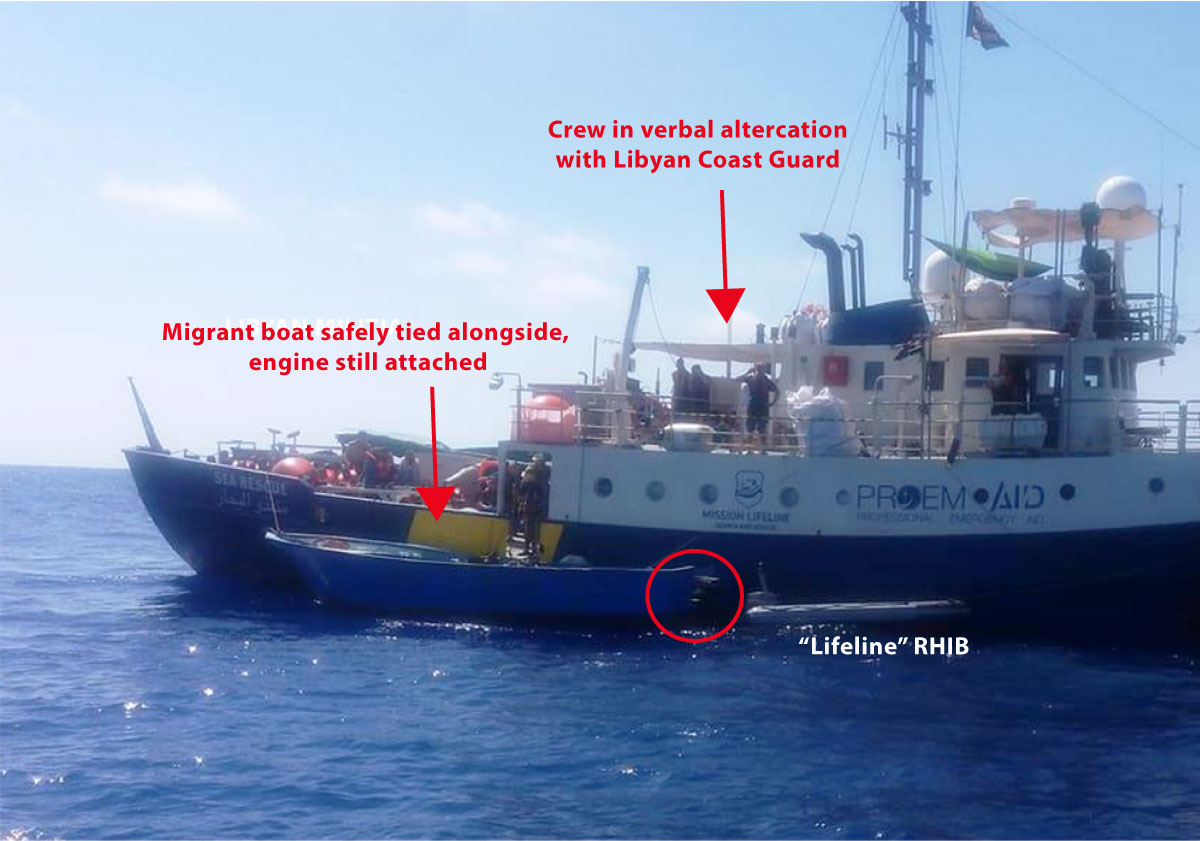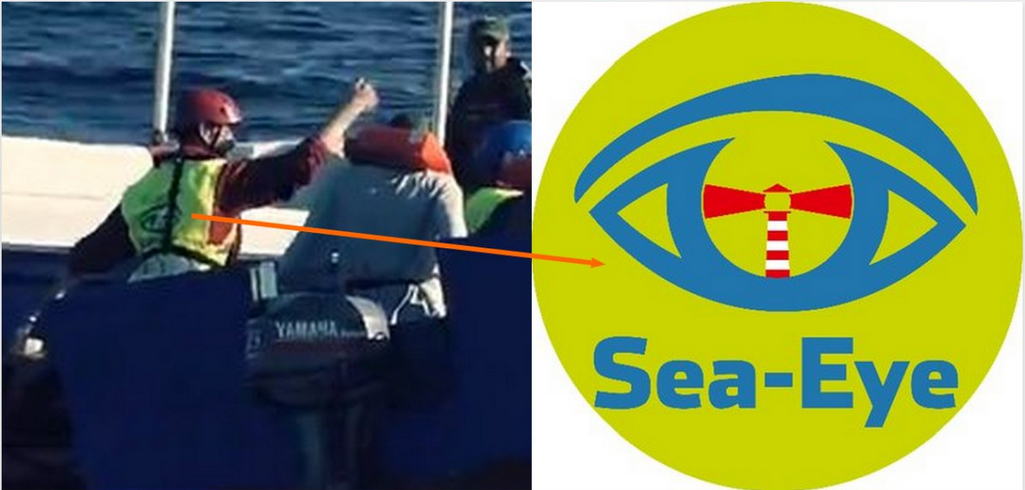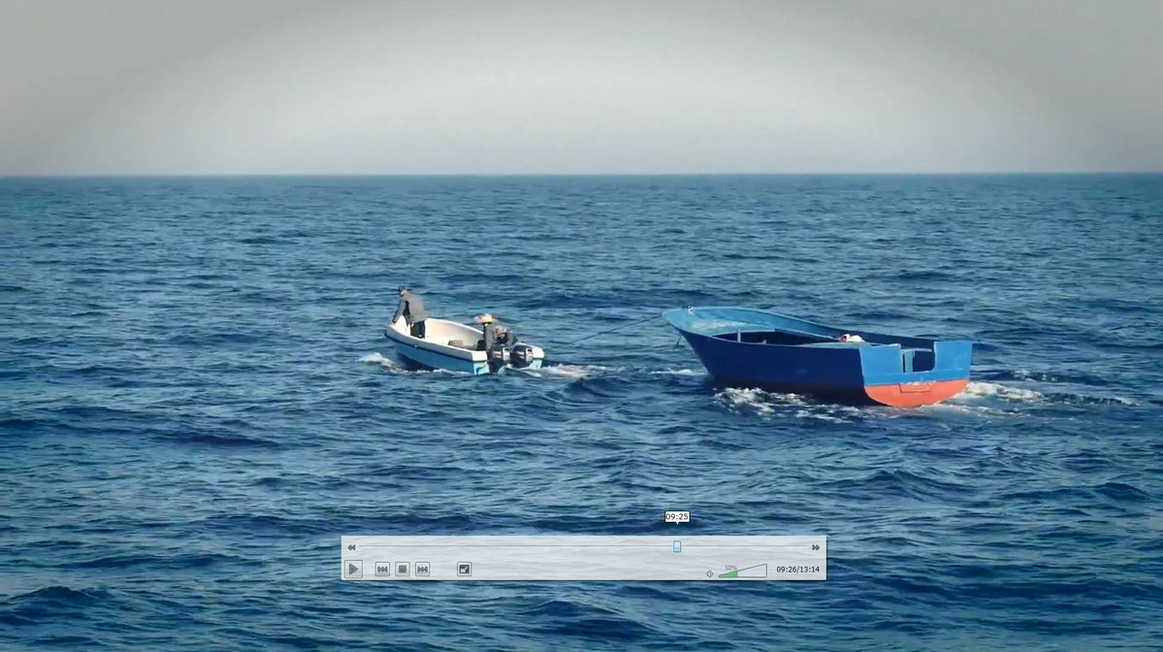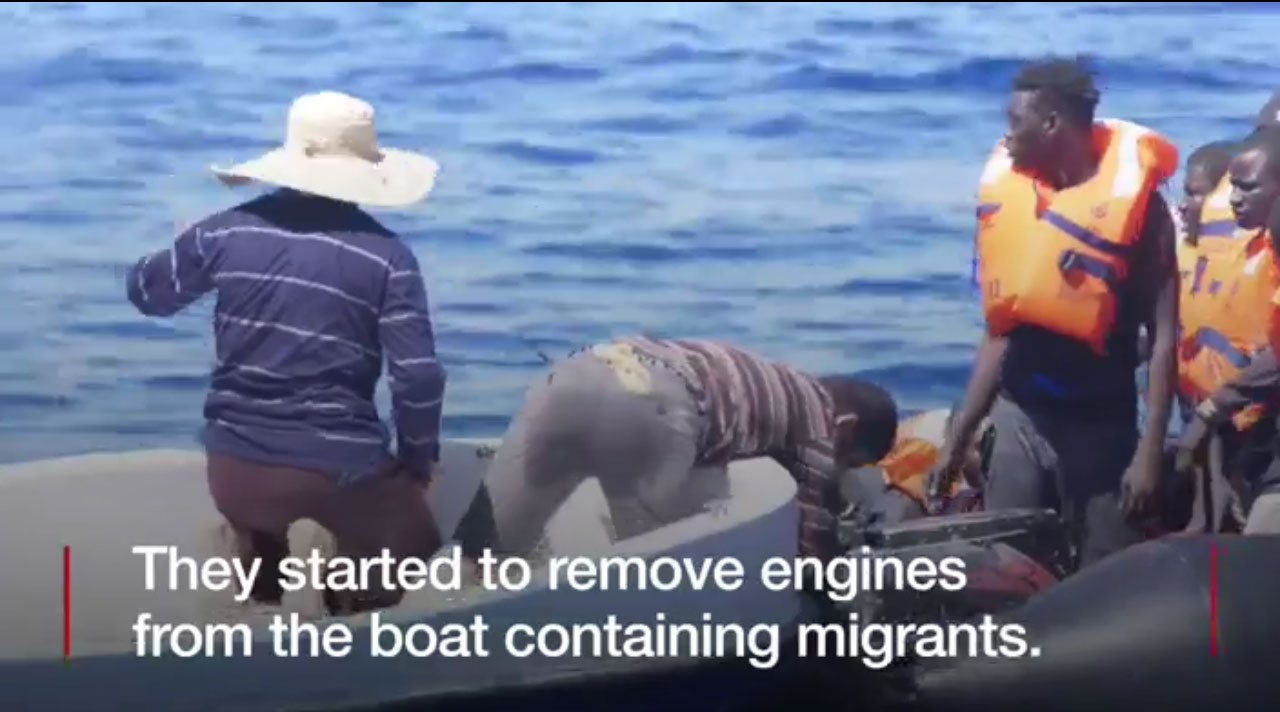Incident with the Libyan Coast Guard on 26.09.2017 – NGO deception & facilitation of illegal immigration

The first discovered wooden boat on 26.09.17 at no time was in danger of sinking or in any type of marine distress. The boat was seaworthy and equipped with a fully functional engine and simply called for “pick up” in a prearranged area. The migrants did not show any medical emergency requiring an assistance or transfer to another vessel as required by the international law and rescue at sea. (see “Lifeline” photos). The weather condition at the time: sea state – light breeze, weather – clear.
The boat was recovered in Libyan contiguous zone only 22,3 NM from the shore (confirmed by the Libyan Coast Guard – see map). Subsequently all migrants were illegally transferred on board the NGO vessel MV “Lifeline” (EU Council Directive 2002/90/EC). Later the boat was pro forma destroyed (burnt).

Video of the incident provided by the Libyan Coast Guard (26.09.2017)
What followed was a legal intervention of the Libyan Coast Guard and its vessel the LCG “Talil” (267).
The LCG vessel approached the MV “Lifeline” trying to establish repeatedly a radio contact to no avail. The Captain Friedhold Ulonska refused to communicate with the LCG vessel issuing instead an emergency call on “Chanel 16” asking for assistance.

Capt. Friedhold Ulonska on board the MV “Lifeline” – “Mission I” (formerly in command of another German NGO vessel the MV “Sea-Eye”)
Repeated calls by the LCG vessel to stop engines and an attempt at verbal communication with the captain were also left unanswered!
The captain’s reckless and life endangering stance led ultimately to a single warning shot and boarding of the MV “Lifeline” by an unarmed LCG officer. During boarding a heated altercation ensued between LCG officer and “Lifeline” crew member. The LCG officer demanded the return of illegal migrants. The crew vehemently refused to comply with this demand. After an unsuccessful verbal persuasion the LCG officer simply returned onboard the LCG “Talil”.
During the incident, at no time did the Libyan Coast Guard “attack” or “shoot at” the MV “Lifeline as claimed by the German NGOs. These claims are simply untrue!

Video provided by “Mission Lifeline e.V.” although edited shows clearly the incident. (26.09.2017)
The entire procedure was conducted in full accordance of the international law and standard rules of engagement practiced by any law enforcement agency at sea (see Coast Guard rules of engagement).

The Libyan Coast Guard vessel LCG “Talil” (267) involved in incident. (26.09.2017)
(*) According to international law responsible government agencies have the right to stop & board any foreign vessel suspected of immigration infractions UNCLOS’82 Art. 33.

Position of MV “Lifeline” in Libyan contiguous zone (22,3 NM) during “pick up”. (26.09.2017)
Screenshots of photos published by the German NGO “Mission Lifeline e.V.” on Twitter showing the “pick up”.

“Lifeline” RHIB” approaching the seaworthy migrant boat. (26.09.2017)

The “rescued” migrants (26.09.2017)

The illegal transfer of migrants on board the MV” Lifeline”. Note on the right side German state TV MDR reporter Mr. Markus Weinberg. (26.09.2017)

The destruction of migrant’s boat. (26.09.2017)
The “Fake News”
The German NGO provided in local press a “fictive narrative” of the incident in the hope of gathering a large media resonance and at the same time financial support of the public. Some of the headlines: “Dresden men rescue hundreds in Mediterranean and get shot at”, “Coast Guard shooting at Lifeline” and “Soldiers shoot at Saxonian refugee helpers”. (SIC!) Very similar pattern & narrative was used by another German NGO the “Sea Watch e.V.” during their incident with the LCG on 10.05 2017.

Headlines from local Saxonian press
The man behind the deception

Mr. Axel Steier, Chairman of “Mission Lifeline e.V. – Dresden, Germany
A known far-left & “no border” activist. In 2015 co-founded an initiative “Dresden Balkan Konvoi” in support of NGOs & migrants in Idomeni camp (Greece). On 23.06.2017 Mr. Axel Steier was summoned by the German Federal Police Inspectorate being accused of “attempted smuggling of illegal aliens into the country”. His first brush with the law in conjunction with facilitation of illegal immigration.

Police summon
The vessel MV “Lifeline”

The MV LIFELINE (Ex- SEA WATCH 2), MMSI 244870698, GT 231, length 32 meters, built 1968, flag Netherlands. Jointly operated by NGO: German “Mission Lifeline e.V.” and Spanish “PROEM-AID”
Source:
* Interview with Libyan Coast Guard – 26.09.2017* Twitter & Facebook: Mission Lifeline e.V. https://twitter.com/SEENOTRETTUNG* Twitter Proem-Aid: https://twitter.com/proemaid* United Nations Convention on the Law of the Sea 1982: http://www.un.org/depts/los/convention_agreements/texts/unclos/unclos_e.pdf* EU Council Directive 2002/90/EC: https://ec.europa.eu/anti-trafficking/legislation-and-case-law-eu-legislation-migration-law/council-directive-200290ec_en
* 29.09.2017 – Tagblatt: “On Tuesday Friedhold Ulonska the captain of ‘Lifeline’ dealt with Libyans” / “Friedhold Ulonska bekam es am Dienstag als Kapitän der ‘Lifeline’ mit den Libyern zu tun”: http://www.tagblatt.de/Nachrichten/Friedhold-Ulonska-bekam-es-am-Dienstag-als-Kapitaen-der-Lifeline-mit-den-Libyern-zu-tun-348112.html* 01.07.2017 – Sachsen Depesche: “Sea rescuers under investigation” / “Ermittlungen gegen Seenotretter “: https://www.sachsen-depesche.de/politik/mission-lifeline-justiz-ermittelt-gegen-axel-steier-und-sascha-pietsch.html


















